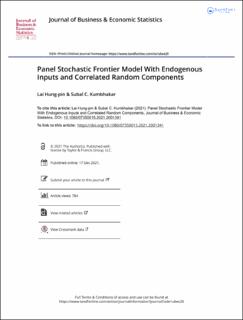Panel Stochastic Frontier Model With Endogenous Inputs and Correlated Random Components
Peer reviewed, Journal article
Published version
Permanent lenke
https://hdl.handle.net/11250/3030953Utgivelsesdato
2021Metadata
Vis full innførselSamlinger
Originalversjon
Journal of business & economic statistics. 2021, 1-18. 10.1080/07350015.2021.2001341Sammendrag
In this article, we consider a panel stochastic frontier model in which the composite error term εit has four components, that is, εit=τi−ηi+vit−uit, where ηi and uit are persistent and transient inefficiency components, τi consists of the random firm effects and vit is the random noise. Two distinguishing features of the proposed model are (i) the inputs are allowed to be correlated with one or more of the error components in the production function; (ii) time-invariant and time-varying components, that is, (τi−ηi) and (vit−uit), are allowed to be correlated. To keep the formulation general, we do not specify whether this correlation comes from the correlations between (i) ηi and uit, (ii) τi and uit, (iii) τi and vit, (iv) ηi and vit, or some other combination of them. Further, we also consider the case when the correlation in the composite error arises from the time dependence of εit. To estimate the model parameters and predict (in)efficiency, we propose a two-step procedure. In the first step, either the within or the first difference transformation that eliminates the time-invariant components is proposed. We then use either the 2SLS or the GMM approach to obtain unbiased and consistent estimators of the parameters in the frontier function, except for the intercept. In the second step, the maximum simulated likelihood method is used to estimate the parameters associated with the distributions of τi and vit, ηi and uit as well as the intercept. The copula approach is used in this step to model the dependence between the time-varying and time-invariant components. Formulas to predict transient and persistent (in)efficiency are also derived. Finally, results from both simulated and real data are provided.

